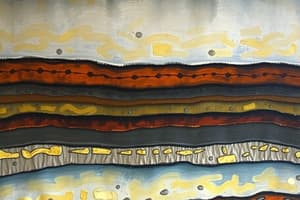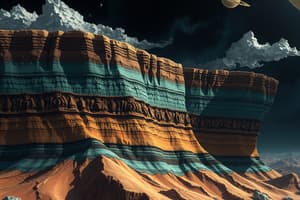Podcast
Questions and Answers
Which type of crust is thicker and composed mainly of granitic rocks?
Which type of crust is thicker and composed mainly of granitic rocks?
- Continental Crust (correct)
- Outer Core
- Mantle
- Oceanic Crust
The oceanic crust is denser than the continental crust.
The oceanic crust is denser than the continental crust.
True (A)
What is the approximate temperature range of the outer core?
What is the approximate temperature range of the outer core?
4,000°C to 6,000°C
The layer between the crust and outer core is called the ______.
The layer between the crust and outer core is called the ______.
Match the geological processes with their descriptions:
Match the geological processes with their descriptions:
What primarily composes the mantle?
What primarily composes the mantle?
The upper mantle is completely solid and does not flow.
The upper mantle is completely solid and does not flow.
What is the primary state of the outer core?
What is the primary state of the outer core?
The movement of liquid iron in the outer core generates the Earth's ______.
The movement of liquid iron in the outer core generates the Earth's ______.
What geological process is driven by convection currents in the mantle?
What geological process is driven by convection currents in the mantle?
Flashcards are hidden until you start studying
Study Notes
Layers of the Earth
Crust Composition
- Definition: The outermost layer of the Earth.
- Types:
- Continental Crust:
- Thicker (30-50 km).
- Composed mainly of granitic rocks.
- Less dense than oceanic crust.
- Oceanic Crust:
- Thinner (5-10 km).
- Composed mainly of basaltic rocks.
- Denser than continental crust.
- Continental Crust:
- Overall Composition:
- Contains silicate minerals.
- Rich in oxygen, silicon, aluminum, iron, calcium, sodium, potassium, and magnesium.
Mantle Characteristics
- Definition: The layer between the crust and outer core.
- Thickness: About 2,900 km.
- Composition:
- Primarily made of silicate minerals rich in iron and magnesium.
- Temperature: Ranges from about 500°C to 4,000°C.
- State:
- Upper mantle is semi-solid (asthenosphere).
- Lower mantle is solid but can flow slowly.
- Convection Currents: Drives plate tectonics and geological activity.
Outer Core Properties
- Definition: The layer beneath the mantle, surrounding the inner core.
- Thickness: Approximately 2,200 km.
- Composition:
- Composed mainly of liquid iron and nickel.
- Contains lighter elements such as sulfur and oxygen.
- State: Liquid due to high temperatures (about 4,000°C to 6,000°C).
- Role in Earth's Magnetic Field: Movement of liquid iron generates the Earth's magnetic field through the dynamo effect.
Geological Processes
- Plate Tectonics:
- Movement of the Earth's lithosphere (crust and upper mantle) on the semi-fluid asthenosphere.
- Volcanism:
- Occurs at tectonic plate boundaries; magma from the mantle rises to the surface.
- Earthquakes:
- Result from the release of stress accumulated along faults in the crust.
- Erosion and Weathering:
- Breakdown of rocks at the Earth's surface due to weather, water, and biological activity.
- Metamorphism:
- Alteration of rock due to heat and pressure, typically occurring in the crust and upper mantle.
Layers of the Earth
Crust Composition
- Outermost layer of the Earth, varying in thickness.
- Continental Crust:
- Thickness ranges from 30-50 km.
- Composed primarily of granitic rocks, making it less dense than oceanic crust.
- Oceanic Crust:
- Thinner layer, measuring 5-10 km in thickness.
- Predominantly made of basaltic rocks, contributing to its greater density compared to continental crust.
- Overall, the crust consists of silicate minerals enriched with oxygen, silicon, aluminum, iron, calcium, sodium, potassium, and magnesium.
Mantle Characteristics
- Positioned between the crust and the outer core, approximately 2,900 km thick.
- Made mostly of silicate minerals enriched in iron and magnesium, contributing to its density.
- Temperature within the mantle varies drastically, from about 500°C in the upper regions to around 4,000°C near the outer core.
- The upper mantle, known as the asthenosphere, exhibits a semi-solid state, while the lower mantle remains solid yet capable of slow flow.
- Convection currents within the mantle are critical for driving plate tectonics and geological activity.
Outer Core Properties
- Located beneath the mantle and encircles the inner core with an approximate thickness of 2,200 km.
- Composed mainly of liquid iron and nickel, contributing to its fluid state at high temperatures (between 4,000°C to 6,000°C).
- Contains lighter elements, including sulfur and oxygen.
- The movement of the liquid iron generates the Earth's magnetic field through the dynamo effect, playing a crucial role in protecting the planet.
Geological Processes
- Plate Tectonics: Involves the movement of the lithosphere (crust and upper mantle) on the semi-fluid asthenosphere, leading to various geological phenomena.
- Volcanism: Occurs at tectonic plate boundaries where magma rises to the surface, often resulting in volcanic eruptions.
- Earthquakes: Arise from the release of accumulated stress along faults within the crust, leading to ground shaking.
- Erosion and Weathering: The process of breaking down rocks at Earth's surface influenced by weather, water, and biological activity.
- Metamorphism: Transformation of rock materials due to elevated heat and pressure, generally occurring in the crust and upper mantle.
Studying That Suits You
Use AI to generate personalized quizzes and flashcards to suit your learning preferences.




